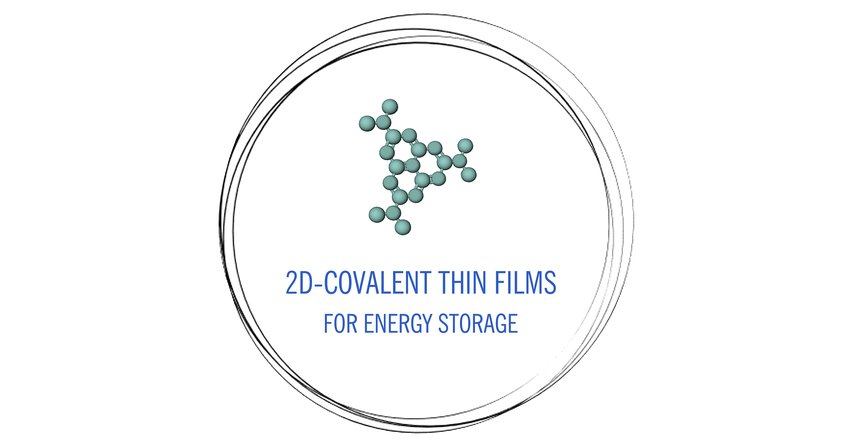
2D-Covalent Thin Films for Energy Storage
In our group, we are driven by the vision to further expand the horizon of common materials. We design and synthesize 2D-covalent thin film materials with controlled chemical composition, structural motifs, morphology, and electronic properties for applications in electrochemical energy devices such as batteries and supercapacitors. Within the framework of the ERC Synergy project MoMa-STOR (ID: 951513), particular focus is placed on thin films for solid electrolyte interfaces (SEI) in sodium-ion battery electrodes.

In recent memory, 2D-covalent organic materials have attracted much interest from the scientific community in varied fields such as catalysis, water purification, sensorics, and energy storage. Aaron Feaver, CTO of EnerG2 stated in 2010:
“Humankind has seen the Stone Age, the Golden Age, and the Iron Age. Some would argue the 20th century should be called the Silicon Age. Based on the events of its first 10 years, the 21st century may very well become known as the Carbon Age.”
Indeed, from the 2000s onward there is an increasing effort spent by chemists and material scientists on the development of new synthetic strategies, correlating chemical and physical properties to application. Nowadays, this effort enables the tailoring these materials to better suit, and target, the application.

What do we define as 2D-covalent materials?
“2D-covalent materials” is a very general term, which is often used to include all organic material from carbon nitrides to boron carbon nitrides and beyond. However, it is not only about boron, carbon, and nitrogen, but also sulfur, oxygen and eventually metals. The common thread here is carbon element, which is often involved in a π-conjugated system and is combined with the proper partner(s) – i.e. the other elements- in a certain fashion leading to very different properties. This is achieved by a careful choice/design of the precursor and a deep understanding of chemical, structural, and topological properties of the product material in order to correlate these properties with the target application result.
While developing highly efficient 2D-covalent materials we always bear in mind the sustainability of the process, from the synthesis to the application.
In our group, we believe that more sustainable materials are the key for a more sustainable and equitable future, from technology, to clean energy and water. While this may seem far-fetched, as nature teaches, solving these problems is simply a matter of putting the right element in the right place.
Why thin films?
Thin films are usually defined as materials with one dimension (i.e the thickness, usually in the order of some micrometers or lower) much smaller than the other two. In a world, where all the devices are getting extremely small as well as more and more efficient (see Moore's law), thin films and interfaces are playing an extremely important role. The design and optimization of thin film materials, with different frameworks and chemical composition, in combination with commonly used bulk materials will enable the increasing of performances, with negligible increase of size and weight.
How can 2D-covalent thin film materials be beneficial in sodium-ion batteries?

As mentioned above, the efficiency of a device is, in many cases, dependent on the material structure and on the interface with other materials. Batteries are not different in this case. A battery includes a series of complex processes beyond the simple ion reduction and oxidation reactions at the electrodes. Here, we seek to control the design of the relevant interfaces, and in particular the solid electrolyte interface, by using coatings of a proper 2D-covalent thin film material at the electrode surface. With improved understanding and design of the interfaces, and in particular the SEI layer, will enable the improving of efficiency and stability of the final battery device.
Credit: Icons vector created by vectorpocket - www.freepik.com





